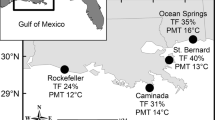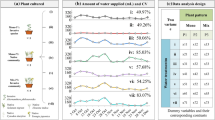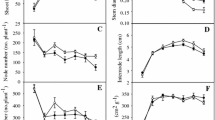Abstract
Although invasive species are often better competitors than native species, broad environmental tolerance may also drive invasion success. Tolerance to abiotic heterogeneity in riparian ecosystems tends to favour the establishment of alien clonal species, as well as their dispersion by vegetative fragments. Hedychium coronarium J. Koenig is a rhizomatous emergent macrophyte native to Asia and has invaded Neotropical riparian ecosystems. We assessed the effect of H. coronarium rhizome exposure to distinct abiotic conditions on ramet growth. We exposed rhizomes to different desiccation periods (1–90 days), temperatures (15, 25 and 35 °C), and light regimes (0, 12, 16 h) and then assessed the effect of each of these variables on subsequent clonal growth (aboveground biomass production per plant and per ramet, and number and height of ramets) under ambient conditions. While no rhizome survived desiccation periods longer than 30 days, ramet growth among surviving rhizomes was not affected by the period of desiccation. Biomass production per rhizome, ramet biomass, and ramet height were significantly lower at 35 °C than at 25 °C. Constant darkness increased rhizome survival, but decreased ramet growth. Although rhizome exposure to extremes of each abiotic variable may hinder the invasion success of H. coronarium, the subsequent aboveground biomass production of surviving rhizomes did not decrease strongly in response to any treatment. This resilience may contribute to successful establishment of H. coronarium after dispersal through rhizome fragments and to varying abiotic conditions.



Similar content being viewed by others
Data availability
All data associated with this manuscript are publicly available in a data repository (https://figshare.com/s/055052aa495dc5b97627).
References
Almeida CT, Oliveira-Júnior JF, Delgado RC, Cubo P, Ramos MC (2017) Spatiotemporal rainfall and temperature trends throughout the Brazilian Legal Amazon, 1973–2013. Int J Climatol 37:2013–2026. https://doi.org/10.1002/joc.4831
Alpert P (2006) Constraints of tolerance: why are desiccation-tolerant organisms so small or rare? J Exp Biol 209:1575–1584
Asaeda T, Rajapakse L, Manatunge J, Sahara N (2006) The effect of summer harvesting of Phragmites australis on growth characteristics and rhizome resource storage. Hydrobiologia 553:327–335. https://doi.org/10.1007/s10750-005-1157-6
Barnes MA, Jerde CL, Keller D, Chadderton WL, Howeth JG, Lodge DM (2013) Viability of aquatic plant fragments following desiccation. Invas Plant Sci Manag 6:320–325
Bart D, Hartman JM (2003) The role of large rhizome dispersal and low salinity windows in the establishment of common reed, Phragmites australis, in salt marshes: new links to human activities. Estuaries 26:436–443. https://doi.org/10.1007/BF02823720
Bates D, Maechler M, Bolker B, Walker S, Christensen RHB, Singmann H, Dai B, Grothendieck G (2016) Package lme4: linear mixed-effects models using Eigen and S4. CRAN Repos 1:1–113
Berković B, Cabaço S, Barrio JM, Santos R, Serrão EA, Alberto F (2014) Extending the life history of a clonal aquatic plant: dispersal potential of sexual and asexual propagules of Zostera noltii. Aquat Bot 113:123–129. https://doi.org/10.1016/j.aquabot.2013.10.007
Catford JA, Jansson R (2014) Drowned, buried and carried away: effects of plant traits on the distribution of native and alien species in riparian ecosystems. New Phytol 204:19–36. https://doi.org/10.1111/nph.12951
Chiba de Castro WA, Moitas ML, Lobato GM, Cunha-Santino MB, Matos DMS (2013) First record of herbivory of the invasive macrophyte Hedychium coronarium J. König (Zingiberaceae). Biota Neotrop 13:3–5. https://doi.org/10.1590/S1676-06032013000400030
Chiba de Castro WA, Almeida RV, Leite MB, Marrs RH, Matos DS (2016) Invasion strategies of the white ginger lily Hedychium coronarium J. König (Zingiberaceae) under different competitive and environmental conditions. Environ Exp Bot 127:55–62
Chiba De Castro WA, Almeida RV, Xavier RO, Bianchini I, Moya H, Silva Matos DM (2019) Litter accumulation and biomass dynamics in riparian zones in tropical South America of the Asian invasive plant Hedychium coronarium J. König (Zingiberaceae). Plant Ecol Divers. https://doi.org/10.1080/17550874.2019.1673496
Chown SL, Slabber S, McGeoch MA, Janion C, Leinaas HP (2007) Phenotypic plasticity mediates climate change responses among invasive and indigenous arthropods. Proc R Soc B 274:2531–2537. https://doi.org/10.1098/rspb.2007.0772
Chu SH, Zhang QS, Liu SK, Tang YZ, Zhang SB, Lu ZC, Yu YQ (2012) Tolerance of Sargassum thunbergii germlings to thermal, osmotic and desiccation stress. Aquat Bot 96:1–6
Colombo AF, Joly CA (2010) Brazilian Atlantic Forest lato sensu: the most ancient Brazilian forest, and a biodiversity hotspot, is highly threatened by climate change. Braz J Biol 70:697–708. https://doi.org/10.1590/S1519-69842010000400002
Costa RO, José CM, Grombone-Guaratini MT, Silva Matos DM (2019) Chemical characterization and phytotoxicity of the essential oil from the invasive Hedychium coronarium on seeds of Brazilian riparian trees. Flora 257:151411. https://doi.org/10.1016/j.flora.2019.05.010
Almeida RV (2015) Invasividade de Hedychium coronarium J. Köenig (Zingiberaceae) em diferentes umidades do solo. Universidade Federal de São Carlos, São Carlos
de Kroon H, Huber H, Stuefer JF, Van Groenendael JM (2005) A modular concept of phenotypic plasticity in plants. New Phytol 166:73–82. https://doi.org/10.1111/j.1469-8137.2004.01310.x
Fleming JP, Dibble ED (2015) Ecological mechanisms of invasion success in aquatic macrophytes. Hydrobiologia 746:23–37. https://doi.org/10.1007/s10750-014-2026-y
Flinn MA, Pringle JK (1983) Heat tolerance of rhizomes of several understory species. Can J Bot 61:452–457
Fox J, Weisberg S (2019) An R companion to applied regression, 3rd edn. Sage, New York
Glover R, Drenovsky RE, Futrell CJ, Grewell BJ (2015) Clonal integration in Ludwigia hexapetala under different light regimes. Aquat Bot 122:40–46. https://doi.org/10.1016/j.aquabot.2015.01.004
Hartung W, Schiller P, Dietz K-J (1998) Physiology of poikilohydric plants. In: Lüttge U, Beyschlag W, Cushman J (eds) Progress in botany. Springer, New York, pp 299–327
Hothorn T, Bretz F, Westfall P (2008) Simultaneous inference in general parametric models. Biometr J 50:346–363. https://doi.org/10.1002/bimj.200810425
Hutchings MJ, Wijesinghe DK (2008) Performance of a clonal species in patchy environments: effects of environmental context on yield at local and whole-plant scales. Evol Ecol 22:313–324. https://doi.org/10.1007/s10682-007-9178-4
Jones D, Bruce G, Fowler MS, Law-Cooper R, Graham I, Abel A, Street-Perrott FA, Eastwood D (2018) Optimising physiochemical control of invasive Japanese knotweed. Biol Invas 20:2091–2105. https://doi.org/10.1007/s10530-018-1684-5
Jongejans E, de Vere N, de Kroon H (2008) Demographic vulnerability of the clonal and endangered meadow thistle. Plant Ecol 198:225–240. https://doi.org/10.1007/s11258-008-9397-y
Juneau KJ, Tarasoff CS (2013) The seasonality of survival and subsequent growth of common reed (Phragmites australis) rhizome fragments. Invas Plant Sci Manag 6:79–86. https://doi.org/10.1614/IPSM-D-12-00051.1
Juneau KJ, Tarasoff CS (2017) The seasonality of survival and subsequent growth of common reed (Phragmites australis) rhizome fragments. Invas Plant Sci Manag 6:79–86. https://doi.org/10.1614/IPSM-D-12-00051.1
Keser L, Dawson W, Song Y-B, Yu F-H, Fischer M, Dong M, van Kleunen M (2014) Invasive clonal plant species have a greater root-foraging plasticity than non-invasive ones. Oecologia 174:1055–1064. https://doi.org/10.1007/s00442-013-2829-y
Kissmann KG, Groth D (1991) Plantas invasoras e nocivas. São Paulo, BASF
Konlechner TM (2008) The management challenge posed by marine dispersal of terrestrial plants in coastal dune systems. NZ Geogr 64:154–156. https://doi.org/10.1111/j.1745-7939.2008.00139.x
Konlechner TM, Orlovich DA, Hilton MJ (2016) Restrictions in the sprouting ability of an invasive coastal plant, Ammophila arenaria, from fragmented rhizomes. Plant Ecol 217:521–532. https://doi.org/10.1007/s11258-016-0597-6
Krajšek SS, Bahčič E, Čoko U, Koce J (2020) Disposal methods for selected invasive plant species used as ornamental garden plants. MBI 11:293–305. https://doi.org/10.3391/mbi.2020.11.2.08
Lawson JR, Fryirs KA, Lenz T, Leishman MR (2015) Heterogeneous flows foster heterogeneous assemblages: relationships between functional diversity and hydrological heterogeneity in riparian plant communities. Freshw Biol 60:2208–2225. https://doi.org/10.1111/fwb.12649
Liu J, Dong M, Miao S, Li Z, Song M, Wang R (2006) Invasive alien plants in China: role of clonality and geographical origin. Biol Invas 8:1461–1470. https://doi.org/10.1007/s10530-005-5838-x
Maciel LA, Siles MFR, Bitencourt MD (2011) Alterações na vegetação herbácea de floresta ombrófila densa decorrentes do uso em uma trilha turística na Serra do Mar em São Paulo, Brasil. Acta Bot Brasil 25:628–632
Manish M (2013) Current status of endangered medicinal plant Hedychium coronarium and causes of population decline in the natural forests of Anuppur and Dindori districts of Madhya Pradesh, India. Int Res J Biol Sci 2:1–6
Mann JJ, Barney Jacob N, Kyser Guy B, Di Tomaso JM (2013) Miscanthus × giganteus and Arundodonax shoot and rhizome tolerance of extreme moisture stress. GCB Bioenergy 5:693–700. https://doi.org/10.1111/gcbb.12039
Maurer DA, Zedler JB (2002) Differential invasion of a wetland grass explained by tests of nutrients and light availability on establishment and clonal growth. Oecologia 131:279–288. https://doi.org/10.1007/s00442-002-0886-8
Michelan TS, Thomaz SM, Carvalho P, Rodrigues RB, Silveira MJ (2010) Regeneration and colonization of an invasive macrophyte grass in response to desiccation. Nat Conserv 8:133–139
Oborny B, Kun Á (2002) Fragmentation of clones: how does it influence dispersal and competitive ability. In: Stuefer JF, Erschbamer B, Huber H, Suzuki J-I (eds) Ecology and evolutionary biology of clonal plants. Springer, Dordrecht, pp 97–124
Pinheiro J, Bates D, DebRoy S, Sarkar D, R Core Team (2018) nlme: linear and nonlinear mixed effects models R package version 3.1–137. R Foundation, Vienna
Portela R, Dong B-C, Yu F-H, Barreiro R, Roiloa SR, Silva Matos DM (2020) Trans-generational effects in the clonal invader Alternanthera philoxeroides. J Plant Ecol 13:122–129. https://doi.org/10.1093/jpe/rtz043
Pumisutapon P, Visser RGF, de Klerk G-J (2012) Moderate abiotic stresses increase rhizome growth and outgrowth of axillary buds in Alstroemeria cultured in vitro. Plant Cell Tissue Organ Cult 110:395–400. https://doi.org/10.1007/s11240-012-0160-7
R Core Team (2020) R: a language and environment for statistical computing, version 4.0.1. R Foundation for Statistical Computing, Vienna
Ray A, Jena S, Dash B, Kar B, Halder T, Chatterjee T, Ghosh B, Panda PC, Nayak S, Mahapatra N (2018) Chemical diversity, antioxidant and antimicrobial activities of the essential oils from Indian populations of Hedychium coronarium Koen. Ind Crops Prod 112:353–362
Rooney N, Kalff J (2000) Inter-annual variation in submerged macrophyte community biomass and distribution: the influence of temperature and lake morphometry. Aquat Bot 68:321–335. https://doi.org/10.1016/S0304-3770(00)00126-1
Ruiz JM, Romero J (2001) Effects of in situ experimental shading on the Mediterranean seagrass Posidonia oceanica. Mar Ecol Prog Ser 215:107–120
Rusterholz H-P, Wirz D, Baur B (2012) Garden waste deposits as a source for non-native plants in mixed deciduous forests. Appl Veg Sci 15:329–337. https://doi.org/10.1111/j.1654-109X.2011.01175.x
Serra do Vale Duarte G, Pott VJ, Lemke AP, Rondon Súarez Y (2015) Efeito das características ambientais sobre a riqueza e composição de macrófitas aquáticas em córregos urbanos. Ciência e Natura 37:74–79
Silva VPR (2004) On climate variability in Northeast of Brazil. J Arid Environ 58(4):575–596
Simberloff D, Rejmánek M (2010) Encyclopedia of biological invasions. University of California Press, Berkeley
Valéry L, Fritz H, Lefeuvre J-C, Simberloff D (2008) In search of a real definition of the biological invasion phenomenon itself. Biol Invas 10:1345–1351
Van Kleunen M, Weber E, Fischer M (2009) A meta-analysis of trait differences between invasive and non-invasive plant species. Ecol Lett 13:235–245. https://doi.org/10.1111/j.1461-0248.2009.01418.x
Voesenek LACJ, van der Putten WH, Maun MA, Blom CWPM (1998) The role of ethylene and darkness in accelerated shoot elongation of Ammophila breviligulata upon sand burial. Oecologia 115:359–365. https://doi.org/10.1007/s004420050528
Westwood CG, Teeuw RM, Wade PM, Holmes NTH, Guyard P (2006) Influences of environmental conditions on macrophyte communities in drought-affected headwater streams. River Res Appl 22:703–726
Acknowledgements
We are thankful to J. R. Estêvão, J. Romero, and M. Martins for their support during the fieldwork and experiment monitoring; São Paulo Research Foundation [2016-19522-5 for its financial support]. DMSM thanks the Brazilian National Council for Scientific and Technological Development (307839/2014-1).
Funding
This work was supported by the São Paulo Research Foundation [Grant No. 2016-19522-5 to D.M.S.M] and the Conselho Nacional de Desenvolvimento Científico e Tecnológico [Grant No. 078392014-1 to D.M.S.M].
Author information
Authors and Affiliations
Contributions
DMSM and AMP conceived the ideas and designed the methodology. AMP collected the data. ROX analysed the data. ROX and WD led the writing of the manuscript. All authors contributed critically to the drafts and gave final approval for publication.
Corresponding author
Ethics declarations
Conflict of interest
Authors declare that they have no conflict of interest to disclose.
Additional information
Communicated by Martin Nunez.
Publisher's Note
Springer Nature remains neutral with regard to jurisdictional claims in published maps and institutional affiliations.
Rights and permissions
About this article
Cite this article
Pinheiro, A.M., Silva Matos, D.M., Dawson, W. et al. Effect of rhizome exposure to contrasting abiotic conditions on the performance of the invasive macrophyte Hedychium coronarium J. Koenig (Zingiberaceae). Plant Ecol 222, 375–385 (2021). https://doi.org/10.1007/s11258-020-01112-2
Received:
Accepted:
Published:
Issue Date:
DOI: https://doi.org/10.1007/s11258-020-01112-2




